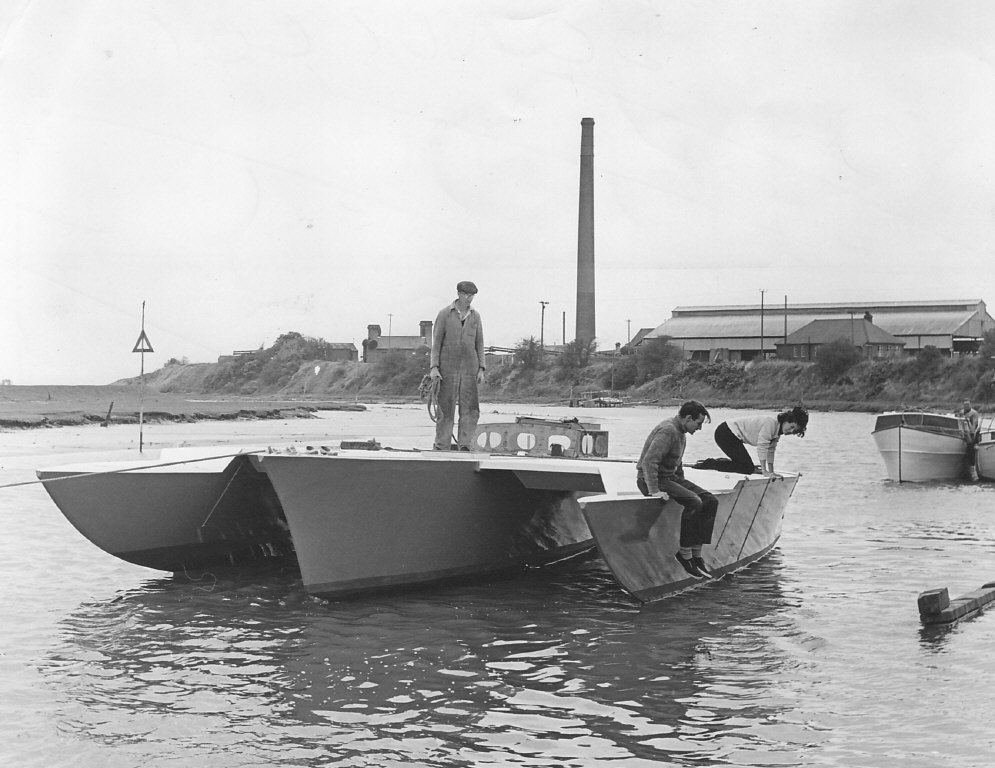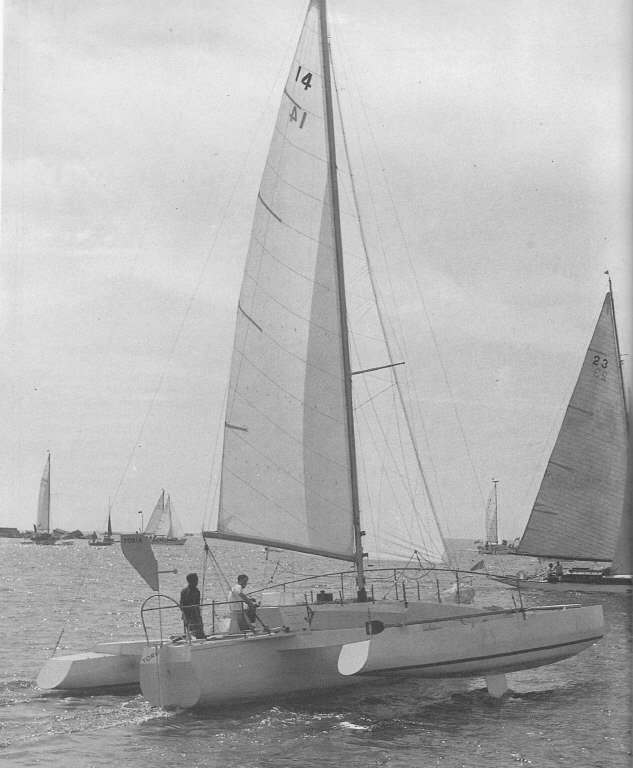This post features a brief record of multihull designer Derek Kelsall’s participation in the 1964 OSTAR race. He was enjoying much success until his boat was unexpectedly damaged.
You can read his account below as well as see a few of his vintage pics from that time … now half a century ago.
Amazing how far multihulls have come since then.
…………..
A Brief Account of Racing My Trimaran FOLATRE in OSTAR 64
by Derek Kelsall
 On 16th March, 50 years ago, while in the Bahamas, I made the spur of the moment decision to enter OSTAR, the second single handed trans Atlantic race from Plymouth, UK to Newport R.I. I ordered three hulls from a builder in UK and two days later I visited a boat builder in N. Kent. With the help of Clare chasing everything needed and an apprentice, I put the 35 ft. tri together.
On 16th March, 50 years ago, while in the Bahamas, I made the spur of the moment decision to enter OSTAR, the second single handed trans Atlantic race from Plymouth, UK to Newport R.I. I ordered three hulls from a builder in UK and two days later I visited a boat builder in N. Kent. With the help of Clare chasing everything needed and an apprentice, I put the 35 ft. tri together.
wo months after leaving the Bahamas, I lead the fleet of 17 out of Plymouth Sound on the first non ballasted yacht to complete the race. Two cats were in the race but both with deep keels and lead ballast. Five days out, with only Eric Tabarly, the eventual winner, ahead by just a few miles, I was sitting on deck with a broken rudder and a broken dagger board. I had hit and ridden over something at ten kts. A restart after repairs back in Plymouth and the crossing took 34 days, with lots of very slow days. Only 3 men had sailed faster. These were the times when we had no two way radios. The total cost was what I had saved in a two year contract in the Sahara desert 3 years earlier.
with only Eric Tabarly, the eventual winner, ahead by just a few miles, I was sitting on deck with a broken rudder and a broken dagger board. I had hit and ridden over something at ten kts. A restart after repairs back in Plymouth and the crossing took 34 days, with lots of very slow days. Only 3 men had sailed faster. These were the times when we had no two way radios. The total cost was what I had saved in a two year contract in the Sahara desert 3 years earlier.
 Obviously, I occasionally think of what might have been. What if there had been no collision. What if I had continued W instead of returning for repairs. What if I had spent the extra money on a spinnaker. That win made Eric Tabarly a national hero, awarded the Legion d’ Honeur by Charles de Gaule.
Obviously, I occasionally think of what might have been. What if there had been no collision. What if I had continued W instead of returning for repairs. What if I had spent the extra money on a spinnaker. That win made Eric Tabarly a national hero, awarded the Legion d’ Honeur by Charles de Gaule.
One very interesting fact of my trimaran Folatre, was the ketch rig and the crude self steering I had put together myself, which was useless. With fine adjustment to the to the rudder and sheeting of the three sails, which often took 15-20 minutes, she steered herself for hours at a time. With so little to do, this was an easy crossing compared to my two previous Atlantic crossings. Although beautiful Clare was waiting for me, all of the time while making good progress in the right direction, I enjoyed the routine of navigating, eating and sleeping, without ever feeling anxious to arrive. Alone at sea, without means of communication, had a certain fascination, akin to driving thro the desert, but one I cannot explain. Today, the solo sailors spend lots of time talking to people on land.
 Later trimarans came to dominate OSTAR and all ocean racing. However, the performance of the top tris today is far beyond our wildest dreams 50 years ago, when maintaining ten kts was unheard of.
Later trimarans came to dominate OSTAR and all ocean racing. However, the performance of the top tris today is far beyond our wildest dreams 50 years ago, when maintaining ten kts was unheard of.
Two years later, I entered the first Round Britain race on Toria and won. 2000 miles, two handed with four 48 hour stops along the way. A great concept, which is another Blondie Hasler event promoted by the Royal Western YC in Plymouth. Of course every race is a great race when every other yacht is behind you. It was my first own design, the first trimaran to win a major ocean race, the first foam sandwich of note and it set the style of arrangement and materials for all who followed. To design, build, skipper and win is, I believe, unique is yacht racing.
Eric Tabarly was my crew from N. Cornwall, into Earls Court in London for the Jan 1967 boat show. It was Eric’s introduction to multihull sailing. Back in France he built Pen Duick 1V. At that point every young French sailor wanted to go racing and wanted to sail a trimaran. The explosion of interest lead to the French domination of both the races and boat building. Another what might have been – I look at the multi aluninum tube tri and compare to the work we were doing at that time in foam sandwich. How I would have loved to have got my hands on that project.
My involvement with OSTAR continued. My foam sandwich experience brought me the contract to build the beautiful Robert Clark design, the 58 ft. Sir Thomas Lipton, for Geoffrey Williams, who won in 1968. The yachts had moved on. More electronics went into Sir Thomas than my 1964 whole campaign cost. A strange reversal of interests to go to building monos after winning on multis. Of course, I continued to design and build multis. Further involvement included more entries and trophies for clients in both the RBR and OSTAR as well as joining the race committees.
Building Sir Thomas, lead on to building 78 ft. Alan Gurney design GB11 for Chay Blyth (First to finish in the first Whitbread around the World, which went on to building trimarans, GB 111 and GB 1V and a few more trophies. But that would cover another chapter at least.
My interest in expanding the multihull field and improving foam construction methods became the adventure. These topics keep me as busy and dedicated as ever. Catamarans in particular have expanded into almost all sectors of boating and our build technique KSS brings us contracts from countries around the World.





0 Comments